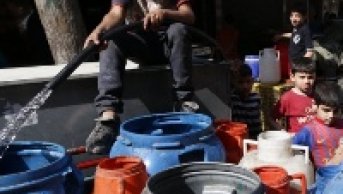Combating Water Shortage in Somalia

Although the Transitional Federal Government (TFG) was dissolved when Hassan Sheikh Mohamud was elected as the president of Somalia on Sept. 10, 2012, the political crisis in the country remains unresolved.
The atmosphere of conflict that has continued for two decades has affected people's lives and caused migrations. The most important reason why people lead a nomadic lifestyle is the ongoing civil war in the country that has been fought since 1991, but another reason is the unpredictable climate which can change from year to year.
Somalia, where an arid or semi-arid climate prevails, is one of the countries with the most variant precipitation rates between years, and these fluctuations directly affect activities such as agriculture and livestock in the country. Precipitation has a bimodal distribution characteristic. The Gu season, when precipitation starts, covers April and June, while Deyr is the rainiest season, covering July and September. Jilal is the driest season of the year, covering December to March, and the season from July to September is called Hagaa. The mean annual precipitation of the country is 282 mm with 500 mm in the northern highlands, 150 mm in the interior plateau, 350-500 mm in the southwest, and 50 mm along the northern coast.
The most important water resources in Somalia are the Juba and Shabelle rivers. While 90 percent of the Juba-Shabelle basin's water originates in the Ethiopian highlands, the basin, with a total area of 810,427 square kilometers, covers one-third of Ethiopia, one-third of Kenya and one-third of Somalia. While the mean annual runoff at the Ethiopian-Somali border is 5.9 billion cubic meters for the Juba River, it is 2.3 billion cubic meters for the Shabelle River. The discharge of the Shabelle River is decreasing due to losses from seepage, evaporation, spillage due to low channel capacity and water extractions through pumps and drains, and thus the flow doesn't reach the wetlands. Until the 1990s, especially in 1946, 1961, 1981, and 1997 to 1998, the Juba and Shabelle rivers also caused destructive floods in Ethiopia during the heavy rain seasons. There are no dams on the Juba and Shabelle rivers. The pre-war flood-control measures have fallen into disrepair. The renewable water resources in Somalia are 14.2 billion cubic meters. According to the 2003 statistics from the UN Food and Agriculture Organization (FAO), total water withdrawal is estimated to be 3,298 billion cubic meters. A total of 99.5 percent of the water is used for irrigation and livestock, while a very small amount is used for drinking and industrial purposes. Under normal circumstances, surface water withdrawal amounts to 96 percent and groundwater withdrawal to 4 percent. However, water is supplied from groundwater during the dry season, and this situation leads to an excessive decrease in the water table.
Drought, prevailing more in the south of the country, causes a decrease in water resources and makes it impossible for some communities to access water. Losing their livestock, the people are going through financial difficulties. People try the temporary solution of using trucks to carry water to the affected areas. In addition to this method, drilling wells is another option to provide water in the region. Nevertheless, there is also a shortage of the technical means that would provide access to water, in addition to the water shortage itself.
It is necessary to drill wells in Somalia to access water resources. To this end, Turkey took steps to realize the “Somalia Clean Water Access Project” initiative from the Turkish Cooperation and Coordination Agency (TİKA) in 2011, with the technical support of the State Waterworks Authority (DSİ). The DSİ launched the drinking water supply projects in Somalia in September 2011. There are severe problems regarding the quality of drinking water in the country.
The pre-war drinking water supply system of the capital, Mogadishu, needs to be renovated. The DSİ started towards this end with a team from Erzurum, and then another from Eskişehir. They carried out tests to find a sufficient amount of unsalted water through geophysical methods. The DSİ team began field work with a boring machine and other Turkish equipment, drilling wells in the tent cities of Mogadishu where people have escaped the war, and then went to regions with large settlements along with another team from the Ministry of Health.
There have been attempts to meet the water requirements of people who could not access it or had other water-related problems through the wells opened so far, and there has also been a drop in the number of water-related diseases. According to the DSİ, while 20 wells have been drilled in Mogadishu and 175,000 people have been provided with drinking and domestic water, three wells have been drilled in Somaliland and 25,000 people have been provided with drinking and domestic water there. Also, the water needs of hospitals, schools and new settlements will be provided through those wells. The project, supported by TİKA and the DSİ, is still operating in the region.





